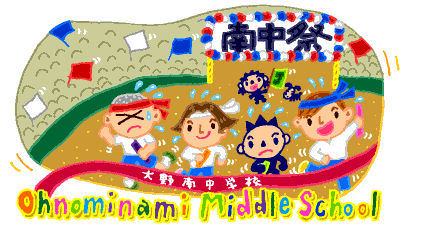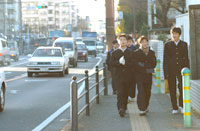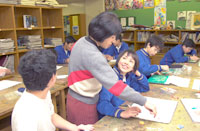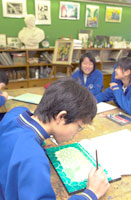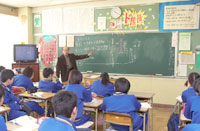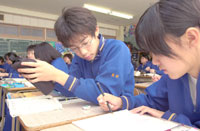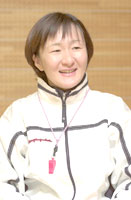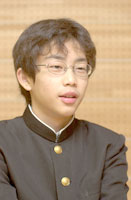Ohnominami Middle School
Morning Classes Ohnominami Middle School is about 15 minutes on foot from Sagamiohno Station, one of the main train stations in Sagamihara City. Around the station is a bustling business district, bristling with hotels, department stores, and offices. Nearby is a densely populated residential area with many high-rise apartment blocks, a university, and schools. Almost all the students at Ohnominami live within 20 minutes' walk of the school. Students who are members of clubs that hold early-morning training sessions, such as the handball and soccer clubs, start their training in the school ground at 7:30, even in the cold of winter. Most of the other students arrive around 8:15. Students have to be in their classroom by 8:30 at the latest, when homeroom starts.
The Kids Web Welcoming Committee's Sho Okuda and Akino Shintani are classmates in class 2-6. When we looked into their classroom, homeroom had started. Their homeroom teacher Ms. Kayoko Sawada, a physical education teacher, was addressing the class enthusiastically. Homeroom lasts 15 minutes, from 8:30 to 8:45. Class 2-6, which also has choir practice for a school concert coming up soon, is full of pep right from the start of the day.
First Period -- Art Each lesson lasts 50 minutes. Class 2-6 has Art as its first lesson today. The whole class moves to the art room and starts on "image painting" under the guidance of the art teacher, Ms. Mie Ito. "Image painting" involves each student painting on a panel the image that comes to mind in connection with a poem or piece of music they have chosen themselves. An abstract design is first of all done on a sketchpad. This is then transferred to a panel, and the work is developed using techniques like collage.
The rate of progress varies from student to student, but Sho Okuda, who is good at art, has almost completed his work. He has chosen a piece of music from the soundtrack to one of his favorite cartoons as his theme, and his picture is dancing with brilliant colors. Akino Shintani, on the other hand, who says she likes pictures but is not good at painting, is still at the drawing stage. "The students of class 2-6 produce good paintings," says Ms. Ito. Although they were talking animatedly, the students were getting on with the work in hand.
Class 2-6 is back in its homeroom again. After a break of 10 minutes, the second period starts--Social Studies. At Ohnominami, the Social Studies curriculum is divided into Geography for the first year, Japanese History for the second, and Civics for the third. Today's lesson for class 2-6 is on the last phase of the Edo Period (1603-1868), when the events leading up to the opening of Japan to the West were taking place.
As the history teacher, Mr. Kiyoshi Namba, writes an outline of the main currents of the Meiji Restoration of 1868 on the blackboard, the students copy it into their notebooks. For the latter half of the lesson, the students watch an animation video designed to teach about the state of society at the time. For Akino, this is a happy time. "I'm not very good at history, but I enjoy the video," she explains. In contrast, Sho is quite a history fan: "I'm really more interested in Western history, where you can study a wider range of events than in Japanese history. I'm particularly interested in the Renaissance period."
   |

